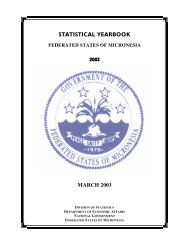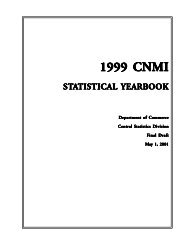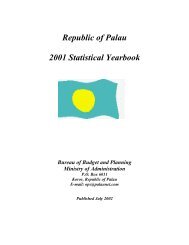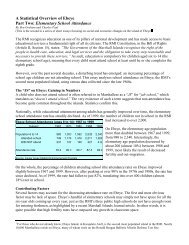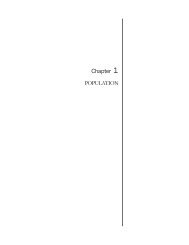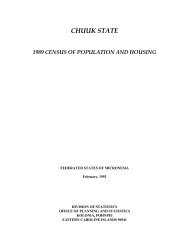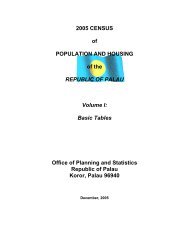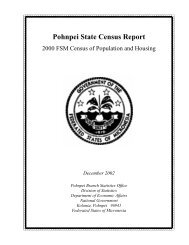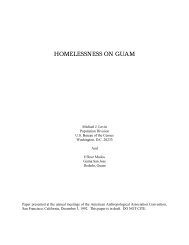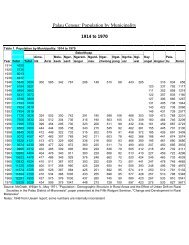Chapter 5. Mortality2000 FSM <strong>Census</strong> of <strong>Chuuk</strong> <strong>State</strong>indices) once a model is matched to the population. Given the model life table the crude death rate was estimated to beapproximately 7 per 1,000 individuals.Table 5.1: Average Age-specific Mortality Rates, <strong>Chuuk</strong> <strong>State</strong>: 1992 to 1995 and 1996 to 19991992-1995 1996-1999Mid-period Age-specific Mid-period Age-specificAge groups Deaths population mortality rate Deaths population mortality rateTotal 186 52,155 3.6 218 53,378 4.10 to 4 years 39 8,472 4.6 39 7,925 4.95 to 9 years 6 8,075 0.7 4 7,727 0.510 to 14 years 5 7,483 0.6 5 7,546 0.615 to 19 years 3 5,861 0.6 4 6,384 0.520 to 24 years 4 4,231 1.0 6 4,627 1.225 to 29 years 5 3,410 1.3 7 3,709 1.830 to 34 years 6 3,104 2.0 7 3,162 2.135 to 39 years 7 2,789 2.4 8 2,853 2.640 to 44 years 7 2,311 2.9 7 2,508 2.645 to 49 years 11 1,610 6.5 16 1,969 7.950 to 54 years 9 1,018 9.1 16 1,234 12.855 to 59 years 15 1,028 14.1 14 944 14.660 to 64 years 16 931 17.5 24 890 27.065 to 69 years 14 710 20.1 16 710 22.970 to 74 years 17 578 29.8 18 547 32.975 yrs & over 24 543 44.2 31 643 47.4Source: Department of Health Services, FSM; 1994 & 2000 FSM <strong>Census</strong>es, unpublished data.Infant and Child Mortality Rates, and Life Expectancy at BirthThe life table is indirectly estimated from child survival information (see United Nations Manual X "IndirectTechniques for Demographic Estimations"). The 2000 FSM <strong>Census</strong> asked women for the number of children everborn and the number of children surviving. With these data, estimations were made about the level of child mortalityover the past 15 to 20 years. This technique assumes that the survivorship of children from women in different agegroups reflects the child mortality for given periods before the census. This technique provides estimations of infantmortality, child mortality, and life expectancy at birth for different years prior to the census. When we apply thismethod to the past four censuses we can approximate the change in level over the three decades before the census.The method requires the calculation of children who were born to mothers aged 15 to 49 but died before the census.The average age of children born to mothers in each five-year age group provides a convenient way of tracingmortality. As mothers age, so too does the average age of their children. As the proportion dead represents the risk ofdying between birth and the average age of children at the time of the census, by calculating this rate for successiveages of mothers, the method essentially describes the mortality pattern for infants and children.Table 5.2 shows the historical trends of proportion of children surviving by age of mother. As can be seen from thetable, the proportion of children surviving has increased over time. In 1973 only 82 percent of children born to womenaged 45 to 49 years survived to the census day. In 2000, the proportion of children surviving has increased to about 93percent. Thus we can assume that mortality in <strong>Chuuk</strong> improved between 1973 and 2000.Table 5.2: Number of Children Ever Born (CEB) and Children Surviving (CS) and Proportion Surviving (PS) by Age Group of Mother, <strong>Chuuk</strong> <strong>State</strong>: 1973 to 20001973 1980 1989 1994 2000Age groups CEB CS PS (%) CEB CS PS (%) CEB CS PS(%) CEB CS PS (%) CEB CS PS(%)15 to 19 years 282 262 92.9 292 269 92.1 190 182 95.8 246 239 97.2 252 244 96.820 to 24 years 1,990 1,828 91.9 1,803 1,692 93.8 1,504 1,455 96.7 1,441 1,360 94.4 1,431 1,362 95.225 to 29 years 3,292 2,993 90.9 3,750 3,510 93.6 3,666 3,505 95.6 3,487 3,283 94.1 3,222 3,065 95.130 to 34 years 3,380 3,055 90.4 4,800 4,496 93.7 5,644 5,398 95.6 5,881 5,484 93.2 4,826 4,578 94.935 to 39 years 5,124 4,477 87.4 3,955 3,642 92.1 6,618 6,275 94.8 7,217 6,772 93.8 6,447 6,089 94.440 to 44 years 4,065 3,396 83.5 4,345 3,989 91.8 5,340 4,982 93.3 7,516 6,992 93.0 7,209 6,786 94.145 to 49 years 3,366 2,763 82.1 3,958 3,619 91.4 3,539 3,299 93.2 5,704 5,296 92.8 6,868 6,356 92.5Source: 1973 TTPI <strong>Census</strong>, Table T25 & T26; 1980 TTPI <strong>Census</strong>, Table T19; 1989 <strong>Chuuk</strong> <strong>Census</strong>; 1994 & 2000 FSM <strong>Census</strong>es, Table P15.Data on children ever born and children surviving classified by age of mother can be used to determine probabilities ofsurviving to specific ages. These probabilities of surviving can then be fitted to a model life table, which allows us tocalculate the approximate infant mortality rates and the corresponding life expectancy at birth for different timeperiods. The resulting mortality indices for recent censuses are summarized in Tables 5.3. The results show a declinein mortality rates over the 20 years before the census. Data for women aged 15 to 19 years were ignored because thenumbers were small and child mortality for young mothers is often selectively high. Mothers in the final three age44 <strong>Chuuk</strong> Branch Statistics Office, Division of Statistics, FSM Department of Economic Affairs
2000 FSM <strong>Census</strong> of <strong>Chuuk</strong> <strong>State</strong>Chapter 5. Mortalitygroups were also disregarded because their poor recollection resulted in an underestimate of the morality rates. Themost accurate information applied to women aged 20 to 34 years. These calculations could be done separately formales and females; however, in order to have an adequate number of cases the data here are presented for both sexes.Table 5.3: Indirect Estimates of Early Age Mortality CEB/CS, <strong>Chuuk</strong> <strong>State</strong>: 1973 to 2000Children Probability of Infant ChildAge GroupsEver Children Proportion Age dying by Reference Mortality Mortality LifeBorn (CEB) Surviving Dead (x) age (x) Date Rate Rate expectancy197320 to 24 years 1.475 1.355 0.081 2 0.088 Aug. 1971 0.075 0.032 59.125 to 29 years 3.525 3.204 0.091 3 0.093 Nov. 1969 0.073 0.030 59.530 to 34 years 5.281 4.773 0.096 5 0.098 Aug. 1967 0.071 0.029 59.9198020 to 24 years 1.088 1.021 0.062 2 0.066 Jul. 1978 0.057 0.021 62.925 to 29 years 2.643 2.474 0.064 3 0.065 Oct. 1976 0.053 0.019 63.930 to 34 years 4.465 4.182 0.063 5 0.065 Sep. 1974 0.049 0.017 64.7198920 to 24 years 0.862 0.834 0.032 2 0.036 Oct. 1987 0.032 0.008 68.925 to 29 years 2.200 2.104 0.044 3 0.045 Jan. 1986 0.038 0.011 67.530 to 34 years 3.773 3.608 0.044 5 0.045 Nov. 1983 0.036 0.010 68.1199420 to 24 years 0.651 0.614 0.057 2 0.063 Jul. 1992 0.054 0.019 63.625 to 29 years 2.042 1.922 0.059 3 0.062 Apr. 1991 0.051 0.017 64.430 to 34 years 3.664 3.417 0.067 5 0.072 Sep. 1989 0.054 0.019 63.7200020 to 24 years 0.630 0.600 0.048 2 0.052 Mar. 1998 0.046 0.015 65.525 to 29 years 1.586 1.508 0.049 3 0.050 Jul. 1996 0.042 0.013 66.530 to 34 years 3.072 2.914 0.051 5 0.053 Jun. 1994 0.042 0.012 66.7Source: 1973 & 1980 TTPI <strong>Census</strong>es, unpublished data; 1989 <strong>Chuuk</strong> <strong>State</strong> <strong>Census</strong>; 1994 & 2000 FSM <strong>Census</strong>es, unpublished data.The estimates provide mortality indices for years prior to the census (see the reference dates in Table 5.3). Theaverages of the three age groups 20 to 24, 25 to 29, and 30 to 34 give the most accurate data and apply to an averagereference date of about 4 years before each census.Table 5.4 presents the average of these age groups and summarized the indicators. The 2000 data provide estimatesthat refer to 1996, the data from 1994 refer to 1990, the data from 1989 refer to 1986, the data from 1980 refer to 1976,and the 1973 data refer to 1969.Mortality indicators improved during both time intervals. The ratio of infant deaths to births in a year decreased fromabout 73 per 1,000 persons to 43 per 1,000 between 1969 and 1996. The probability of dying between ages 1 and 5decreased from 30 per 1,000 in 1969 to 13 in 1996. The average length of life that a person could expect to liveincreased by 6.7 years between 1969 and 1996.Table 5.4: Summary Indicators from Indirect Estimation of Early Age Mortality, <strong>Chuuk</strong> <strong>State</strong>: 1969 to 1996Reference dateInfant Mortality Child Mortality Liferate (per '000) rate (per '000) Expectancy1996 43 13 66.21990 53 18 63.91986 35 10 68.21976 53 19 63.81969 73 30 59.5Source: Preceding Table 5.3Note: These rates are calculated using the Coale-Demeny life table model West 20.The trend observed in infant mortality and life expectancy at birth could have been slightly distorted by the quality ofthe mortality data in earlier censuses. As was the case in many developing countries, the quality of data collection isimproving over time (better educated enumerators and respondents, improved computer technology, more <strong>org</strong>anizedcensus administration and management systems, etc.). In this respect, the higher life expectancy and lower infantmortality rate observed in 1976 could be partly due to suspected underreporting on mortality data in 1980 census.Nevertheless, given the results of the 2000 <strong>Census</strong> alone, the high level of infant mortality rate should be a real worryfor <strong>Chuuk</strong> state policy makers, especially in the health sector.Table 5.5 compares the mortality rates of <strong>Chuuk</strong> and the overall FSM to other neighboring Pacific Islands nations.<strong>Chuuk</strong>’s infant mortality rate of 43 only trailed Kiribati, which had the highest infant mortality rate.<strong>Chuuk</strong> Branch Statistics Office, Division of Statistics, FSM Department of Economic Affairs 45
- Page 5:
iii
- Page 12 and 13:
Preface2000 FSM Census of Chuukx
- Page 14 and 15:
Table of contents2000 FSM Census of
- Page 16 and 17:
LIST OF TEXT TABLESTABLEPageChapter
- Page 18 and 19:
List of Text Table2000 FSM Census o
- Page 20 and 21:
LIST OF FIGURESFIGUREPageFigure 1.1
- Page 22 and 23: List of Basic-Tables2000 FSM Census
- Page 24 and 25: MAP OF FSMxxiiChuuk Branch Statisti
- Page 27 and 28: 2000 FSM Census of Chuuk StateExecu
- Page 29 and 30: CHAPTER 1INTRODUCTIONThe creation o
- Page 31 and 32: 2000 FSM Census of Chuuk StateChapt
- Page 33 and 34: 2000 FSM Census of Chuuk StateChapt
- Page 35 and 36: 2000 FSM Census of Chuuk StateChapt
- Page 37 and 38: 2000 FSM Census of Chuuk StateChapt
- Page 39 and 40: 2000 FSM Census of Chuuk StateChapt
- Page 41 and 42: 2000 FSM Census of Chuuk StateChapt
- Page 43 and 44: 2000 FSM Census of Chuuk State Chap
- Page 45: 2000 FSM Census of Chuuk StateChapt
- Page 48 and 49: Chapter 2. Age and Sex Structure200
- Page 50 and 51: Chapter 2. Age and Sex Structure200
- Page 52 and 53: Chapter 2. Age and Sex Structure200
- Page 55 and 56: CHAPTER 3HOUSEHOLDS, FAMILIES, AND
- Page 57 and 58: 2000 FSM Census of Chuuk StateChapt
- Page 59 and 60: 2000 FSM Census of Chuuk StateChapt
- Page 61: 2000 FSM Census of Chuuk StateChapt
- Page 64 and 65: Chapter 4. Fertility2000 FSM Census
- Page 66 and 67: Chapter 4. Fertility2000 FSM Census
- Page 68 and 69: Chapter 4. Fertility2000 FSM Census
- Page 71: CHAPTER 5MORTALITYIntroductionAs re
- Page 75: 2000 FSM Census of Chuuk StateChapt
- Page 78 and 79: Chapter 6. Migration2000 FSM Census
- Page 80 and 81: Chapter 6. Migration2000 FSM Census
- Page 82 and 83: Chapter 6. Migration2000 FSM Census
- Page 84 and 85: Chapter 6. Migration2000 FSM Census
- Page 86 and 87: Chapter 7. Religion, Ethnicity, and
- Page 88 and 89: Chapter 7. Religion, Ethnicity, and
- Page 90 and 91: Chapter 7. Religion, Ethnicity, and
- Page 92 and 93: Chapter 8. Education2000 FSM Census
- Page 94 and 95: Chapter 8. Education2000 FSM Census
- Page 96 and 97: Chapter 8. Education2000 FSM Census
- Page 98 and 99: Chapter 8. Education2000 FSM Census
- Page 100 and 101: Chapter 8. Education2000 FSM Census
- Page 103 and 104: CHAPTER 9ECONOMIC ACTIVITYIntroduct
- Page 105 and 106: 2000 FSM Census of Chuuk StateChapt
- Page 107 and 108: 2000 FSM Census of Chuuk StateChapt
- Page 109 and 110: 2000 FSM Census of Chuuk StateChapt
- Page 111 and 112: 2000 FSM Census of Chuuk StateChapt
- Page 113 and 114: 2000 FSM Census of Chuuk StateChapt
- Page 115 and 116: 2000 FSM Census of Chuuk StateChapt
- Page 117 and 118: CHAPTER 10INDUSTRY AND OCCUPATIONIn
- Page 119 and 120: 2000 FSM Census of Chuuk StateChapt
- Page 121 and 122: 2000 FSM Census of Chuuk StateChapt
- Page 123 and 124:
2000 FSM Census of Chuuk StateChapt
- Page 125 and 126:
2000 FSM Census of Chuuk StateChapt
- Page 127 and 128:
2000 FSM Census of Chuuk StateChapt
- Page 129 and 130:
CHAPTER 11INCOMEIntroductionThe 200
- Page 131 and 132:
2000 FSM Census of Chuuk StateChapt
- Page 133 and 134:
2000 FSM Census of Chuuk StateChapt
- Page 135 and 136:
2000 FSM Census of Chuuk StateChapt
- Page 137:
2000 FSM Census of Chuuk StateChapt
- Page 140 and 141:
Chapter 12. Housing2000 FSM Census
- Page 142 and 143:
Chapter 12. Housing2000 FSM Census
- Page 144 and 145:
Chapter 12. Housing2000 FSM Census
- Page 146 and 147:
Chapter 12. Housing2000 FSM Census
- Page 148 and 149:
Chapter 12. Housing2000 FSM Census
- Page 150 and 151:
Chapter 12. Housing2000 FSM Census
- Page 152 and 153:
Chapter 12. Housing2000 FSM Census
- Page 154:
Chapter 12. Housing2000 FSM Census
- Page 157 and 158:
BIBLIOGRAPHYArriaga, E.E., (1983).
- Page 159:
2000 FSM Census of Chuuk StateBibli
- Page 162 and 163:
Basic Tables2000 FSM Census of Chuu
- Page 164 and 165:
Basic Tables2000 FSM Census of Chuu
- Page 166 and 167:
Basic Tables2000 FSM Census of Chuu
- Page 168 and 169:
Basic Tables2000 FSM Census of Chuu
- Page 170 and 171:
Basic Tables2000 FSM Census of Chuu
- Page 172 and 173:
Basic Tables2000 FSM Census of Chuu
- Page 174 and 175:
Basic Tables2000 FSM Census of Chuu
- Page 176 and 177:
Basic Tables2000 FSM Census of Chuu
- Page 178 and 179:
Basic Tables2000 FSM Census of Chuu
- Page 180 and 181:
Basic Tables2000 FSM Census of Chuu
- Page 182 and 183:
Basic Tables2000 FSM Census of Chuu
- Page 184 and 185:
Basic Tables2000 FSM Census of Chuu
- Page 186 and 187:
Basic Tables2000 FSM Census of Chuu
- Page 188 and 189:
Basic Tables2000 FSM Census of Chuu
- Page 190 and 191:
Basic Tables2000 FSM Census of Chuu
- Page 192 and 193:
Basic Tables2000 FSM Census of Chuu
- Page 194 and 195:
Basic Tables2000 FSM Census of Chuu
- Page 196 and 197:
Basic Tables2000 FSM Census of Chuu
- Page 198 and 199:
Basic Tables2000 FSM Census of Chuu
- Page 200 and 201:
Basic Tables2000 FSM Census of Chuu
- Page 202 and 203:
Basic Tables2000 FSM Census of Chuu
- Page 204 and 205:
Basic Tables2000 FSM Census of Chuu
- Page 206 and 207:
Basic Tables2000 FSM Census of Chuu
- Page 208 and 209:
Basic Tables2000 FSM Census of Chuu
- Page 210 and 211:
Basic Tables2000 FSM Census of Chuu
- Page 212 and 213:
Basic Tables2000 FSM Census of Chuu
- Page 214 and 215:
Basic Tables2000 FSM Census of Chuu
- Page 216 and 217:
Basic Tables2000 FSM Census of Chuu
- Page 218 and 219:
Basic Tables2000 FSM Census of Chuu
- Page 220 and 221:
Basic Tables2000 FSM Census of Chuu
- Page 222 and 223:
Basic Tables2000 FSM Census of Chuu
- Page 224 and 225:
Basic Tables2000 FSM Census of Chuu
- Page 226 and 227:
Basic Tables2000 FSM Census of Chuu
- Page 228 and 229:
Basic Tables2000 FSM Census of Chuu
- Page 230 and 231:
Basic Tables2000 FSM Census of Chuu
- Page 232 and 233:
Basic Tables2000 FSM Census of Chuu
- Page 234 and 235:
Basic Tables2000 FSM Census of Chuu
- Page 236 and 237:
Basic Tables2000 FSM Census of Chuu
- Page 238 and 239:
Basic Tables2000 FSM Census of Chuu
- Page 240 and 241:
Basic Tables2000 FSM Census of Chuu
- Page 242 and 243:
Basic Tables2000 FSM Census of Chuu
- Page 244 and 245:
Basic Tables2000 FSM Census of Chuu
- Page 246 and 247:
Basic Tables2000 FSM Census of Chuu
- Page 248 and 249:
Basic Tables2000 FSM Census of Chuu
- Page 250 and 251:
Basic Tables2000 FSM Census of Chuu
- Page 252 and 253:
Basic Tables2000 FSM Census of Chuu
- Page 254 and 255:
Basic Tables2000 FSM Census of Chuu
- Page 256 and 257:
Basic Tables2000 FSM Census of Chuu
- Page 258 and 259:
Basic Tables2000 FSM Census of Chuu
- Page 260 and 261:
Basic Tables2000 FSM Census of Chuu
- Page 262 and 263:
Basic Tables2000 FSM Census of Chuu
- Page 264 and 265:
Basic Tables2000 FSM Census of Chuu
- Page 266 and 267:
Basic Tables2000 FSM Census of Chuu
- Page 268 and 269:
Basic Tables2000 FSM Census of Chuu
- Page 270 and 271:
Basic Tables2000 FSM Census of Chuu
- Page 272 and 273:
Basic Tables2000 FSM Census of Chuu
- Page 274 and 275:
Basic Tables2000 FSM Census of Chuu
- Page 276 and 277:
Basic Tables2000 FSM Census of Chuu
- Page 278 and 279:
Basic Tables2000 FSM Census of Chuu
- Page 280 and 281:
Basic Tables2000 FSM Census of Chuu
- Page 282 and 283:
Basic Tables2000 FSM Census of Chuu
- Page 284 and 285:
Basic Tables2000 FSM Census of Chuu
- Page 286 and 287:
Basic Tables2000 FSM Census of Chuu
- Page 288 and 289:
Basic Tables2000 FSM Census of Chuu
- Page 290 and 291:
Basic Tables2000 FSM Census of Chuu
- Page 292 and 293:
Questionnaire2000 FSM Census of Chu
- Page 294 and 295:
Questionnaire2000 FSM Census of Chu
- Page 296 and 297:
Questionnaire2000 FSM Census of Chu



